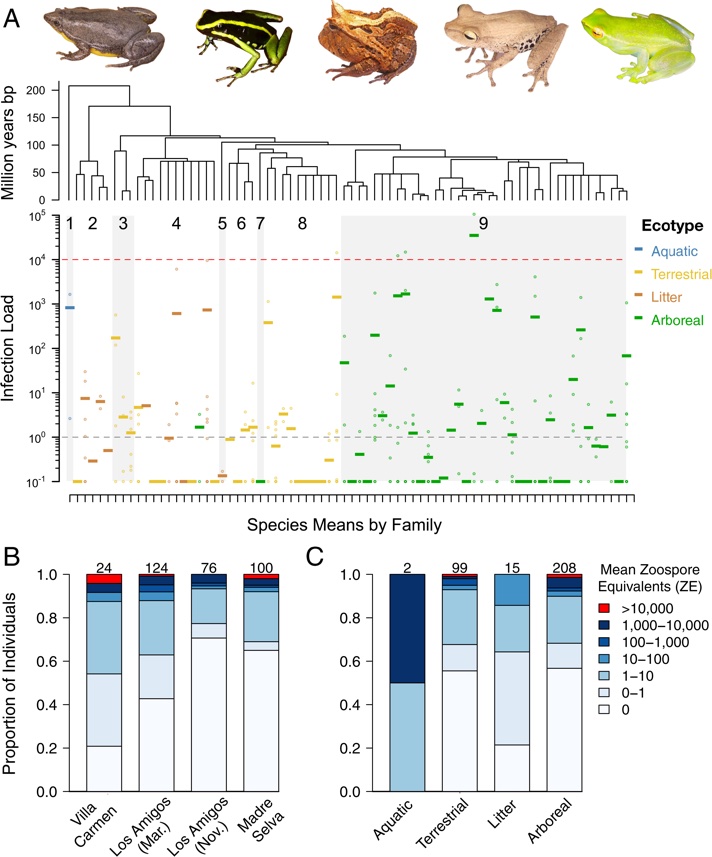Lab studies have shown the fungus cannot survive in temperatures above 29 degrees celsius, but researchers found the fungus surviving in frogs living in temperatures that surpass that threshold.
Batrachochytrium dendrobatidis, the fungus that causes chytridiomycosis, or chytrid was originally thought to have been restricted to cold, mountainous climates, but new research coming out of the University of Michigan suggests that the fungus, which has devastated amphibian populations throughout much of the world, also survives in warm, tropical lowlands.

Imani D. Russell,Joanna G. Larson,Rudolf von May,Iris A. Holmes,Timothy Y. James,Alison R. Davis Rabosky
Widespread high infection loads were not predicted by host or site characteristics. (A) Mean individual (points) and mean species (horizontal dashes; N = 75 species) log10-transformed infection loads (note log scale on the y-axis), ordered by phylogeny (from ref. 36) and colored by ecotype, with representative frog species shown above. Tree branches correspond to each species below. Grey polygons correspond to alternate families, as numbered: 1) Pipidae, 2) Microhylidae, 3) Dendrobatidae 4) Craugastoridae, 5) Ceratophryidae, 6) Bufonidae, 7) Centrolenidae, 8) Leptodactylidae, 9) Hylidae. Horizontal grey dotted line at 100 denotes the load threshold for categorization as a positive infection, horizontal red dotted line at 104 denotes the load threshold for categorization as a heavy infection (ZE > 10,000). Frog images from left to right: Elachistocleis bicolor (Microhylidae), Ameerega trivittata (Dendrobatidae), Ceratophrys cornuta (Ceratophryidae), Hypsiboas maculateralis (Hylidae), and Sphaenorynchus lacteus (Hylidae), with credit for all images to Daniel L. Rabosky. (B) Proportion of individuals at each infection level by collection site. Numbers at top of each bar denote sample sizes. (C) Proportion of individuals at each infection level by ecotype.
Lab studies in the past have shown that the fungus cannot survive in temperatures above 29 degrees celsius, but the researchers found the fungus surviving in frogs living in temperatures that surpass that threshold, tossing that notion out the window.
In 2016 and 2017, researcher Alison Davis Rabosky and her colleagues with the university swabbed 324 frogs collected from a warm, lowlands location in Peru and another location 850 meters above sea level. The research involved 80 frog species. The data showed that the rate of infection was far more prevalent than they had expected, with 24 to 38 per cent of the lowland frogs testing positive for the fungus.
Origin Of Batrachochytrium dendrobatidis Came From Asian Amphibians, New Study Says
Importation Of African Clawed Frogs To The US Also Brought The Chytrid Fungus
It isn’t clear whether this is a new outbreak or whether the fungus has been in the lowland areas for many years, Davis Rabosky told New Scientist. If it is a new infection in the region, then the frogs might start becoming sick and dying in the near future, she said.
The researchers also determined that 46 percent of the frogs from the higher elevations tested positive for the fungus. The researchers also noted that the infected frogs living in the warmer ecosystems didn’t have symptoms that were common in infected frogs living at the higher elevations.
The researchers surmise that the infected frogs in the lowland areas might be spreading the disease, even if these amphibians are displaying signs of infection.
The researchers hope that other amphibian researchers take swabs of all the frogs and toads that they catch.



